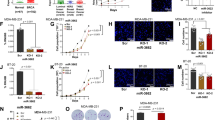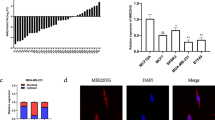Abstract
ErbB2 is a vital breast cancer gene and its overexpression has a decisive role in breast tumor initiation and malignant progression. However, the molecular mechanisms that underlie ErbB2 dysregulation in breast cancer cells remain incompletely understood. In this study, we found that ErbB2 expression is inversely correlated with the level of miR-155, a well-documented oncogenic miRNA, in ErbB2-positive breast tumors. We further determined that miR-155 potently suppresses ErbB2 in breast cancer cells. Mechanistically, miR-155 acts to downregulate ErbB2 via two distinct mechanisms. First, miR-155 represses ErbB2 transcription by targeting HDAC2, a transcriptional activator of ErbB2. Second, miR-155 directly targets ErbB2 via a regulatory element in its coding region. Intriguingly, miR-155 is upregulated by trastuzumab and in turn leads to a reduction of ErbB2 expression in trastuzumab-treated ErbB2-positive breast cancer cells. Functional studies showed that miR-155 inhibits ErbB2-induced malignant transformation of human breast epithelial cells. Thus, our findings reveal an intriguing miR-155-ErbB2 context in regulating the malignant transformation of breast epithelial cells, and thereby indicate a novel mode of action for miR-155 in ErbB2-positive breast cancer.
This is a preview of subscription content, access via your institution
Access options
Subscribe to this journal
Receive 50 print issues and online access
$259.00 per year
only $5.18 per issue
Buy this article
- Purchase on Springer Link
- Instant access to full article PDF
Prices may be subject to local taxes which are calculated during checkout








Similar content being viewed by others
References
Jemal A, Bray F, Center MM, Ferlay J, Ward E, Forman D . Global cancer statistics. Cancer J Clin 2011; 61: 69–90.
Siegel R, Ma J, Zou Z, Jemal A . Cancer statistics, 2014. Cancer J Clin 2014; 64: 9–29.
Slamon DJ, Clark GM, Wong SG, Levin WJ, Ullrich A, McGuire WL . Human breast cancer: correlation of relapse and survival with amplification of the HER-2/neu oncogene. Science 1987; 235: 177–182.
Yu D, Hung MC . Overexpression of ErbB2 in cancer and ErbB2-targeting strategies. Oncogene 2000; 19: 6115–6121.
Eccles SA . The role of c-erbB-2/HER2/neu in breast cancer progression and metastasis. J Mamm Gland Biol Neoplasia 2001; 6: 393–406.
Yarden Y . Biology of HER2 and its importance in breast cancer. Oncology 2001; 61 (Suppl 2): 1–13.
Nofech-Mozes S, Spayne J, Rakovitch E, Hanna W . Prognostic and predictive molecular markers in DCIS: a review. Adv Anat Pathol 2005; 12: 256–264.
Krauss WC, Park JW, Kirpotin DB, Hong K, Benz CC . Emerging antibody-based HER2 (ErbB-2/neu) therapeutics. Breast Dis 2000; 11: 113–124.
Hudis CA . Trastuzumab—mechanism of action and use in clinical practice. N Engl J Med 2007; 357: 39–51.
Hicks DG, Kulkarni S . Trastuzumab as adjuvant therapy for early breast cancer: the importance of accurate human epidermal growth factor receptor 2 testing. Arch Pathol Lab Med 2008; 132: 1008–1015.
Pinto AC, Ades F, de Azambuja E, Piccart-Gebhart M . Trastuzumab for patients with HER2 positive breast cancer: delivery, duration and combination therapies. Breast (Edinburgh, Scotland) 2013; 22 (Suppl 2): S152–S155.
Wu L, Belasco JG . Let me count the ways: mechanisms of gene regulation by miRNAs and siRNAs. Mol Cell 2008; 29: 1–7.
Guarnieri DJ, DiLeone RJ . MicroRNAs: a new class of gene regulators. Ann Med 2008; 40: 197–208.
Garzon R, Marcucci G, Croce CM . Targeting microRNAs in cancer: rationale, strategies and challenges. Nat Rev Drug Discov 2010; 9: 775–789.
Liu H, Brannon AR, Reddy AR, Alexe G, Seiler MW, Arreola A et al. Identifying mRNA targets of microRNA dysregulated in cancer: with application to clear cell renal cell carcinoma. BMC Syst Biol 2010; 4: 51.
Higgs G, Slack F . The multiple roles of microRNA-155 in oncogenesis. J Clin Bioinform 2013; 3: 17.
Pedersen IM, Otero D, Kao E, Miletic AV, Hother C, Ralfkiaer E et al. Onco-miR-155 targets SHIP1 to promote TNFalpha-dependent growth of B cell lymphomas. EMBO Mol Med 2009; 1: 288–295.
Gironella M, Seux M, Xie MJ, Cano C, Tomasini R, Gommeaux J et al. Tumor protein 53-induced nuclear protein 1 expression is repressed by miR-155, and its restoration inhibits pancreatic tumor development. Proc Natl Acad Sci USA 2007; 104: 16170–16175.
Babar IA, Czochor J, Steinmetz A, Weidhaas JB, Glazer PM, Slack FJ . Inhibition of hypoxia-induced miR-155 radiosensitizes hypoxic lung cancer cells. Cancer Biol Ther 2011; 12: 908–914.
Zhang Y, Wei W, Cheng N, Wang K, Li B, Jiang X et al. Hepatitis C virus-induced up-regulation of microRNA-155 promotes hepatocarcinogenesis by activating Wnt signaling. Hepatology (Baltimore, MD) 2012; 56: 1631–1640.
Cai ZK, Chen Q, Chen YB, Gu M, Zheng DC, Zhou J et al. microRNA-155 promotes the proliferation of prostate cancer cells by targeting annexin 7. Mol Med Rep 2015; 11: 533–538.
Jiang S, Zhang H-W, Lu M-H, He X-H, Li Y, Gu H et al. MicroRNA-155 functions as an OncomiR in breast cancer by targeting the suppressor of cytokine signaling 1 gene. Cancer Res 2010; 70: 3119–3127.
Koudelakova V, Berkovcova J, Trojanec R, Vrbkova J, Radova L, Ehrmann J et al. Evaluation of HER2 gene status in breast cancer samples with indeterminate fluorescence in situ hybridization by quantitative real-time PCR. J Mol Diagn 2015; 17: 446–455.
Owens MA, Horten BC, Da Silva MM . HER2 amplification ratios by fluorescence in situ hybridization and correlation with immunohistochemistry in a cohort of 6556 breast cancer tissues. Clin Breast Cancer 2004; 5: 63–69.
Jiang S, Zhang LF, Zhang HW, Hu S, Lu MH, Liang S et al. A novel miR-155/miR-143 cascade controls glycolysis by regulating hexokinase 2 in breast cancer cells. EMBO J 2012; 31: 1985–1998.
Kong W, Yang H, He L, Zhao JJ, Coppola D, Dalton WS et al. MicroRNA-155 is regulated by the transforming growth factor beta/Smad pathway and contributes to epithelial cell plasticity by targeting RhoA. Mol Cell Biol 2008; 28: 6773–6784.
Chang S, Wang RH, Akagi K, Kim KA, Martin BK, Cavallone L et al. Tumor suppressor BRCA1 epigenetically controls oncogenic microRNA-155. Nat Med 2011; 17: 1275–1282.
Dinami R, Ercolani C, Petti E, Piazza S, Ciani Y, Sestito R et al. miR-155 drives telomere fragility in human breast cancer by targeting TRF1. Cancer Res 2014; 74: 4145–4156.
Krek A, Grun D, Poy MN, Wolf R, Rosenberg L, Epstein EJ et al. Combinatorial microRNA target predictions. Nat Genet 2005; 37: 495–500.
Lewis BP, Burge CB, Bartel DP . Conserved seed pairing, often flanked by adenosines, indicates that thousands of human genes are microRNA targets. Cell 2005; 120: 15–20.
Scott GK, Marden C, Xu F, Kirk L, Benz CC . Transcriptional repression of ErbB2 by histone deacetylase inhibitors detected by a genomically integrated ErbB2 promoter-reporting cell screen. Mol Cancer Ther 2002; 1: 385–392.
Kim YJ, Greer CB, Cecchini KR, Harris LN, Tuck DP, Kim TH . HDAC inhibitors induce transcriptional repression of high copy number genes in breast cancer through elongation blockade. Oncogene 2013; 32: 2828–2835.
Sandhu SK, Volinia S, Costinean S, Galasso M, Neinast R, Santhanam R et al. miR-155 targets histone deacetylase 4 (HDAC4) and impairs transcriptional activity of B-cell lymphoma 6 (BCL6) in the Emu-miR-155 transgenic mouse model. Proc Natl Acad Sci USA 2012; 109: 20047–20052.
Witt O, Deubzer HE, Milde T, Oehme I . HDAC family: What are the cancer relevant targets? Cancer Lett 2009; 277: 8–21.
Muller BM, Jana L, Kasajima A, Lehmann A, Prinzler J, Budczies J et al. Differential expression of histone deacetylases HDAC1, 2 and 3 in human breast cancer—overexpression of HDAC2 and HDAC3 is associated with clinicopathological indicators of disease progression. BMC Cancer 2013; 13: 215.
Melton C, Judson RL, Blelloch R . Opposing microRNA families regulate self-renewal in mouse embryonic stem cells. Nature 2010; 463: 621–626.
Huang S, Wu S, Ding J, Lin J, Wei L, Gu J et al. MicroRNA-181a modulates gene expression of zinc finger family members by directly targeting their coding regions. Nucleic Acids Res 2010; 38: 7211–7218.
Qin W, Shi Y, Zhao B, Yao C, Jin L, Ma J et al. miR-24 regulates apoptosis by targeting the open reading frame (ORF) region of FAF1 in cancer cells. PLoS One 2010; 5: e9429.
Zhang X, Li M, Zuo K, Li D, Ye M, Ding L et al. Upregulated miR-155 in papillary thyroid carcinoma promotes tumor growth by targeting APC and activating Wnt/beta-catenin signaling. J Clin Endocrinol Metab 2013; 98: E1305–E1313.
Pouliot LM, Chen YC, Bai J, Guha R, Martin SE, Gottesman MM et al. Cisplatin sensitivity mediated by WEE1 and CHK1 is mediated by miR-155 and the miR-15 family. Cancer Res 2012; 72: 5945–5955.
He M, Xu Z, Ding T, Kuang DM, Zheng L . MicroRNA-155 regulates inflammatory cytokine production in tumor-associated macrophages via targeting C/EBPbeta. Cell Mol Immunol 2009; 6: 343–352.
Lu J, Guo H, Treekitkarnmongkol W, Li P, Zhang J, Shi B et al. 14-3-3zeta Cooperates with ErbB2 to promote ductal carcinoma in situ progression to invasive breast cancer by inducing epithelial-mesenchymal transition. Cancer Cell 2009; 16: 195–207.
Mittendorf EA, Wu Y, Scaltriti M, Meric-Bernstam F, Hunt KK, Dawood S et al. Loss of HER2 amplification following trastuzumab-based neoadjuvant systemic therapy and survival outcomes. Clin Cancer Res 2009; 15: 7381–7388.
Qin W, Ren Q, Liu T, Huang Y, Wang J . MicroRNA-155 is a novel suppressor of ovarian cancer-initiating cells that targets CLDN1. FEBS Lett 2013; 587: 1434–1439.
Cheng CJ, Bahal R, Babar IA, Pincus Z, Barrera F, Liu C et al. MicroRNA silencing for cancer therapy targeted to the tumour microenvironment. Nature 2015; 518: 107–110.
American Type Culture Collection. Cell Line Verification Test Recommendations; ATCC Recommends Cell Line Verification Tests and Guidelines for Publishing, ATCC Technical Bulletin No. 8. American Type Culture Collection: Manassas, VA, 2007.
Zhao S, Gou L-T, Zhang M, Zu L-D, Hua M-M, Hua Y et al. piRNA-triggered MIWI ubiquitination and removal by APC/C in late spermatogenesis. Dev Cell 2013; 24: 13–25.
Wang L, Zhang LF, Wu J, Xu SJ, Xu YY, Li D et al. IL-1beta-mediated repression of microRNA-101 is crucial for inflammation-promoted lung tumorigenesis. Cancer Res 2014; 74: 4720–4730.
Albini A, Benelli R . The chemoinvasion assay: a method to assess tumor and endothelial cell invasion and its modulation. Nat Protocols 2007; 2: 504–511.
Debnath J, Muthuswamy SK, Brugge JS . Morphogenesis and oncogenesis of MCF-10 A mammary epithelial acini grown in three-dimensional basement membrane cultures. Methods 2003; 30: 256–268.
Acknowledgements
We thank Dr Gao-Xiang Ge for suggestions and critical comments on the manuscript. This work was supported by grants from the Ministry of Science and Technology of China (2012CB910803, 2014CB943103 and 2014CB964802), the National Natural Science Foundation of China (31325008, 91419307, 81502267, and 31300656), the Science and Technology Commission of the Shanghai Municipality (13ZR1464300 and 16XD1404900), and the Chinese Academy of Sciences (KJZD-EW-L01-2 and 2013KIP202) and Foundation of Key Laboratory of Gene Engineering of the Ministry of Education.
Author information
Authors and Affiliations
Corresponding author
Ethics declarations
Competing interests
The authors declare no conflict of interest.
Additional information
Supplementary Information accompanies this paper on the Oncogene website
Supplementary information
Rights and permissions
About this article
Cite this article
He, XH., Zhu, W., Yuan, P. et al. miR-155 downregulates ErbB2 and suppresses ErbB2-induced malignant transformation of breast epithelial cells. Oncogene 35, 6015–6025 (2016). https://doi.org/10.1038/onc.2016.132
Received:
Revised:
Accepted:
Published:
Issue Date:
DOI: https://doi.org/10.1038/onc.2016.132
This article is cited by
-
Identification of key genes of anti-programmed death ligand 1 for meningioma immunotherapy by bioinformatic analysis
Medical Oncology (2022)
-
Cancer stem cell secretome in the tumor microenvironment: a key point for an effective personalized cancer treatment
Journal of Hematology & Oncology (2020)
-
Regulatory network of miRNA on its target: coordination between transcriptional and post-transcriptional regulation of gene expression
Cellular and Molecular Life Sciences (2019)
-
Specific microRNA signatures in exosomes of triple-negative and HER2-positive breast cancer patients undergoing neoadjuvant therapy within the GeparSixto trial
BMC Medicine (2018)
-
Receptor tyrosine kinases (RTKs) in breast cancer: signaling, therapeutic implications and challenges
Molecular Cancer (2018)



